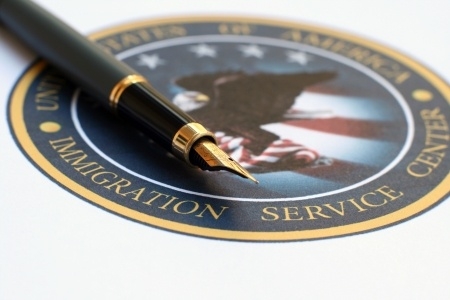“I hereby declare, on oath, that I absolutely and entirely renounce and abjure all allegiance and fidelity to any foreign prince, potentate, state, or sovereignty, of whom or which I have heretofore been a subject or citizen; that I will support and defend the Constitution and laws of the United States of America against all enemies, foreign and domestic; that I will bear true faith and allegiance to the same; that I will bear arms on behalf of the United States when required by the law; that I will perform noncombatant service in the Armed Forces of the United States when required by the law; that I will perform work of national importance under civilian direction when required by the law; and that I take this obligation freely, without any mental reservation or purpose of evasion; so help me God.”
~ Naturalization Oath of Allegiance to the United States of America.
These are the words recited during the naturalization ceremony. It is the ideal for which most immigrants are striving.
Almost every genealogist in the United States can trace their ancestry to an immigrant ancestor who made the monumental decision to come to the United States. The reasons for leaving their homeland were innumerable and the hardships they faced were unimaginable. Immigrants faced many challenges, including a long voyage that could last up to three months in rough water, as well as the challenge of starting a new life in the United States – usually with meager resources. Your immigrant ancestor has a story to tell and naturalization is a part of that story.
Understanding the Naturalization Process
As it is with any genealogical search the genealogist needs to understand the process that led to your immigrant ancestors’ decision to become a United States citizen.
Federal naturalization laws were enacted in 1790, which stipulated that any court could perform the naturalization process. It wasn’t until 1906 when the United States Bureau of Immigration and Naturalization (renamed Immigration and Naturalization Service) provided standard forms to the courts. The United States Immigration and Naturalization Service (INS) has duplicate copies of the naturalization documents filed after 1906. The National Archives also has many of these documents.
The naturalization process historically comprised five steps:
1. Registry – Between 1798 and 1828 immigrants who wished to become United States citizens were required to register with the court upon arrival.
- By the late 1820s the registry step was combined with the next step, The Declaration of Intent.
- By 1928 the Registry was repealed.
2. Declaration of Intent
- The Declaration of Intent provides some genealogical information, such as name of the immigrant, age, birth date and birthplace, nativity, name of monarch to whom the he/she served allegiance, port of departure and arrival, and signature or mark of the immigrant.
- Between 1828 and 1838, many courts opted to use a shorter form that limited the amount of genealogical information gathered.
- After 1906, the forms requested more details, such as name, occupation, description of the immigrant, birthplace, birth date, current residence, foreign residence, and other immigration information.
3. Petition for Naturalization
- Prior to 1906, the Petition for Naturalization did not contain any genealogical information.
- It stated the date and court where the applicant was scheduled to appear, a statement of the immigrant’s desire to become a citizen, an affidavit testifying to the immigrant’s moral character, date and signature or mark of immigrant.
- After 1906, more genealogical information was requested from the immigrant in addition to affidavits of the immigrant and witnesses.
- With this information, a copy of the Declaration of Intent, proof of a five-year residency in the United States and a copy of the petition for naturalization, the immigrant could walk into any court in the country and request full citizenship.
4. Order Granting Citizenship
- If the previous obligations were fulfilled, the Oath of Allegiance was administered in a ceremony.
5. Certificate of Citizenship
- A certificate was issued to the new citizen.
- The court did not retain a copy of the certificate.
An immigrant could buy or sell property, work, marry, or anything of a personal or social nature, but to vote and to participate in the political process required that the immigrant first become a citizen of the United States. Oddly enough, many immigrants never started or completed the naturalization process.
Women automatically became citizens when they married a native-born or naturalized citizen; however, after 1922 a married female immigrant had to naturalize also. Minor children became citizens if the parents were naturalized.
Searching for Naturalization Records
Often the first clue as to when their ancestor immigrated to the United States and naturalized may be found in the United States census schedule. Starting in 1900 the census bureau asked questions about immigration status, such as the date of naturalization and nativity. Several websites hold immigration records including:
- Fee-based, but with some online access.
- Duplicates of court records after 1906 from the United States Citizenship and Immigration Service.
- Some immigration records prior to 1906 that were donated.
- Free to all genealogists.
- Partnership with the National Archives and other genealogy companies to gather immigration records.
- Subscription based, but do have a free basic membership.
- Partnership with the National Archives and Family History.
United States Citizenship and Immigration Service (USCIS)
- Fee based.
- Duplicates of court records after 1906 and additional records.
- USCIS searches five agencies:
1. Naturalization Certification Files between 1906-1956.
2. Alien Registrations between 1940-1944.
3. Visa Files between 1924-1944.
4. Registry Files between 1929-1944.
5. A-Files between 1944-1951.
For pre-1906 records, I would suggest searching the county court records where your immigrant ancestor lived.
Our immigrant ancestors took a risk coming to the United States, and their stories are valuable not only to their descendants, but to American history as a whole. Let the professional genealogists at RecordClick help help you find your immigrant ancestor.







